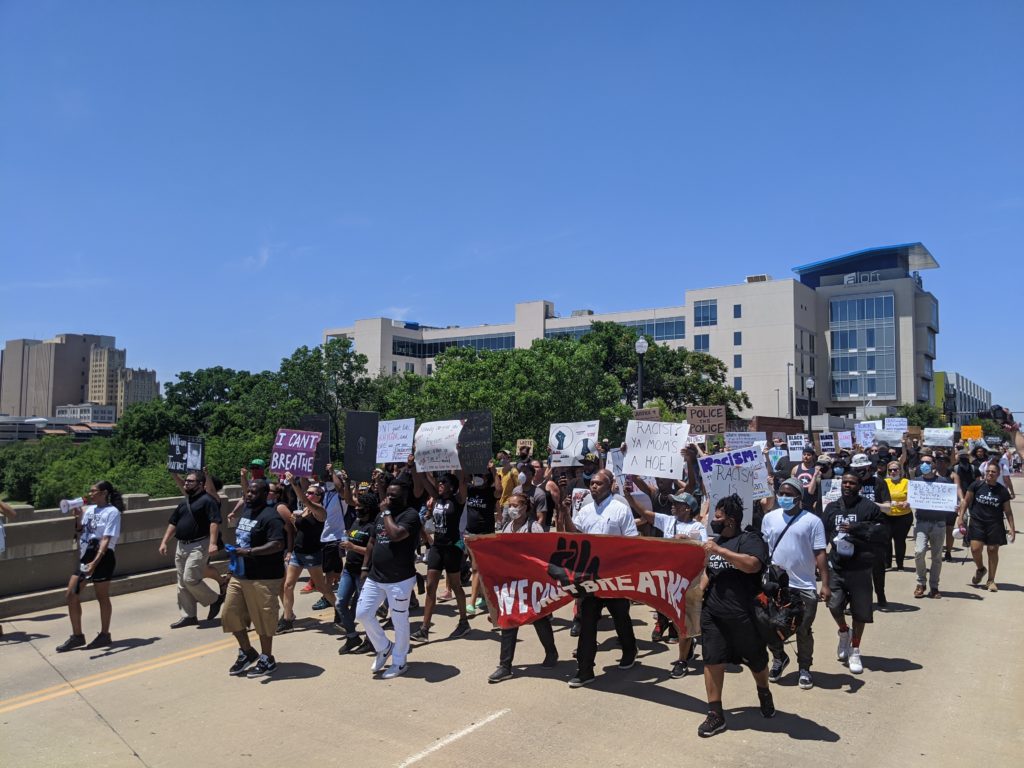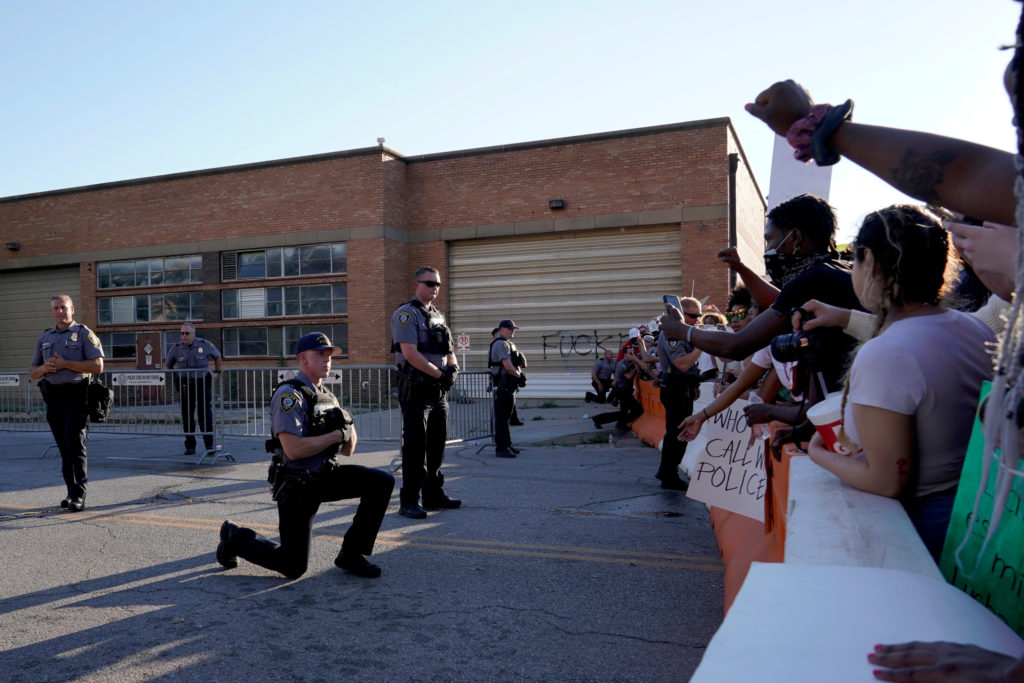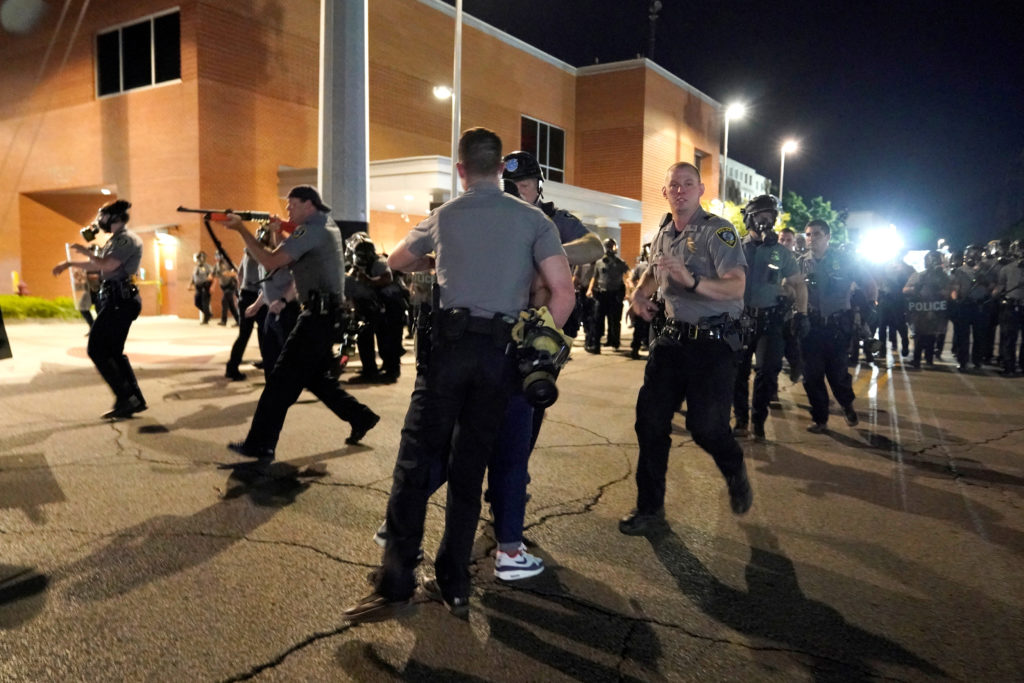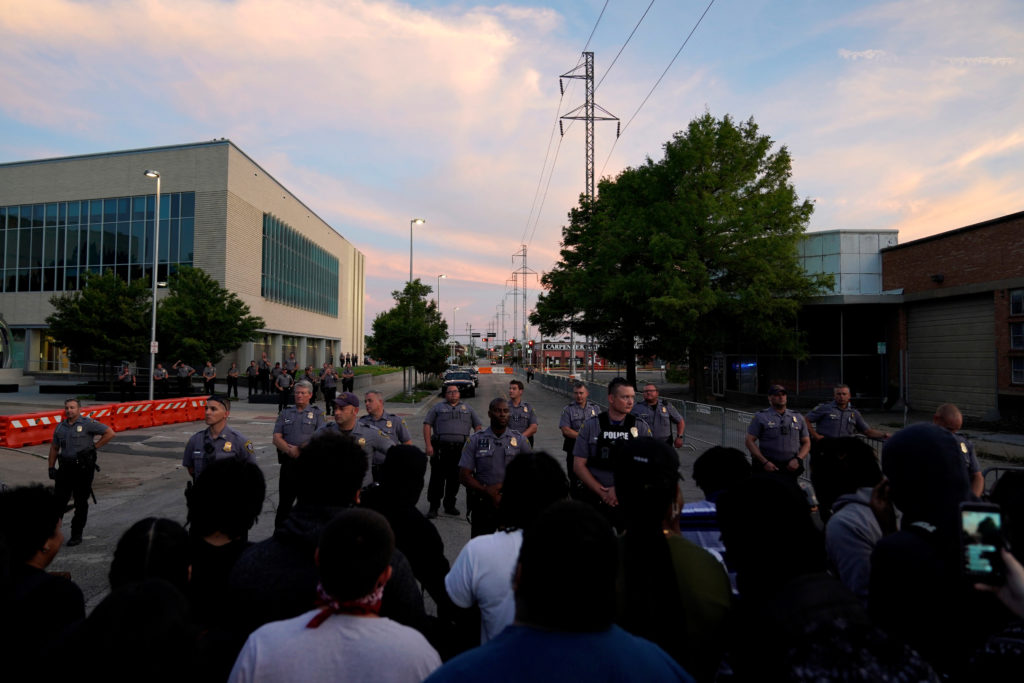OKLAHOMA CITY – The police department in the capital of one of the reddest states in the nation is moving forward with a sweeping plan for reform, one that follows years of advocacy to more meaningfully address police violence in a city that ranks second among the country’s large police departments for the rate of people killed by officers.
The changes are based on a list of 39 new recommendations from 21CP Solutions, an outside firm made up of former law enforcement leaders, public officials, civil rights lawyers and social scientists. The recommendations are designed to not only curb violent interactions between police and the public, but also improve relationships between law enforcement and the communities they serve.
“Nationally, we saw this historic call for a reevaluation of the way our law enforcement operates,” Oklahoma City Mayor David Holt told the PBS NewsHour. “We saw the people here in Oklahoma City marching in the streets and they broadly represented the public and we knew it was important to this community and it needed to be addressed and addressed quickly.”

Oklahoma City residents marched in the streets demanding a change in police accountability as part of nationwide protests after the police killing of George Floyd in Minneapolis. Photo by Adam Kemp/ PBS NewsHour
The 39 recommendations, which the city’s police department began implementing in March, focuses on eight key areas of improvement, including reviewing its de-escalation policy, more training in crisis response and increased transparency following police shootings.
What are the recommendations for police reform in Oklahoma City?
The 39 recommendations focused on eight areas of improvement:
- Law enforcement de-escalation policy
- Independent law enforcement accountability to the community
- Law enforcement training in crisis response
- Alternative response to mental health calls
- Law enforcement focus on youth outreach
- Creation of a neighborhood safety/violence interruption program
- Police officer access to mental health services
- Expansion of law enforcement homeless outreach initiatives
Six months in, the police department has created a dedicated response team to mental health crisis emergencies and trained and hired 47 new crisis intervention team officers. It’s also in the process of hiring a full-time licensed clinical mental health professional by the end of this year, a 21CP representative said.
Oklahoma City is one of several cities across the country that announced their own set of police reforms following Floyd’s death.
In June 2020, San Francisco Mayor London Breed announced her plan for police reform and a racial equity action and inclusion plan that aimed to reduce police responses to non-criminal street crises and the creation of a new crisis response team, eliminating biased policing, demilitarizing the department and “promoting economic justice through budget reallocations that aid traditionally marginalized communities.”
Eugene, Oregon, implemented many of the same changes following Floyd’s death and has had a crisis intervention team for more than 30 years.
In Berkeley, California, officials voted to limit law enforcement involvement in low-level traffic stops. Minneapolis and other cities made commitments to end or reduce police presence in schools and New York City, home to the nation’s largest police force, became the first municipality to end qualified immunity for officers.
Earlier this year, President Joe Biden, who made police reform a major part of his presidential campaign, and his administration proposed more than $32 billion in funding for police in the 2023 budget.
The proposal includes almost $11.2 billion to address violent crime. Within that figure, more than $1 billion would be allocated for new investments in reducing gun violence and violent crime, as well as $3 billion for grant programs that help communities address violent crime, Deputy Attorney General Lisa Monaco announced in March.
Grace Franklin, a poet and the executive director for OKC Artists for Justice, said that like in other communities nationwide, the fight for police reform in Oklahoma City has largely been led by Black and brown leaders — those who are most at risk of being killed by police.
“Issues of racial discrimination between the police and the community can’t be fixed by a new policy or recommendation,” Franklin said. “But I think Oklahoma City is trying to do better and everyone understands that we have to do better and wants to push us that way.”
Black people make up 13 percent of the U.S. population, but are three times more likely to be killed by the police than their white counterparts.
Those numbers hold true in Oklahoma as Black people are 3.2 times more likely to be killed by police, despite making up 12.4 percent of the population, according to the Mapping Police Violence database.
Franklin said there’s been a hesitancy by local leaders to acknowledge the history of policing how patrols were originally created as an extension of slavery, reconstruction and Jim Crow laws.
“Until we can address that and acknowledge and start changing the foundation and full ideology of policing, we will still come up short,” Franklin said.
“I think police are trained in a ‘us v. them’ mentality,” she added . “If we are always at odds, how can we be treated with respect and humanity? That’s what needs to change first.”

Oklahoma City officers guard police headquarters during nationwide demonstrations days after the police killing of George Floyd in Minneapolis. Photo by Nick Oxford/Reuters
Ganesha Martin, a criminal justice and police reform expert with 21CP Solutions, has been guiding the police department in implementing the new recommendations, including speaking with community members and local leaders to help bridge those kinds of disconnects.
Martin, an attorney, worked for the city of Baltimore as the assistant deputy mayor before leaving to work in the Baltimore Police Department. Martin was working for the department when Freddie Gray, a 25-year-old Black man, was killed in police custody, spurring protests and riots across the city for 17 days.
Martin later became the point person for the Department of Justice’s Civil Rights Division and worked to prompt conversation between the police, elected officials, as well as corporate and community leaders.
“Often it just starts with needing to listen,” Martin said. “So many times we all get caught in the headlines and the community sees it one way and the police see it another way, and it’s not until we really stop and take the time to listen to each other that we can start understanding each other and working to make those changes happen.”
What are the initial steps?

Oklahoma City Police officers arrest a person during a protest following the Minneapolis Police killing of George Floyd, May 31, 2020. REUTERS/Nick Oxford
Following the protests and calls for reform after Minneapolis police officer Derek Chavin’s murder of George Floyd in 2020, Oklahoma City Mayor David Holt, a Republican, announced the formation of the Law Enforcement Policy Task Force and a community policing working group. The city hired 21CP Solutions, a Chicago-based consulting firm of former law enforcement professionals, to provide recommendations for how city police can prioritize de-escalation, improve officer wellness and provide alternatives to mental health calls.
21CP Solutions drafted an 85-page report, including its 39 recommendations, after conducting a survey of 1,600 Oklahoma City residents. It found that 94 percent were “very supportive” or “supportive” of police increasing de-escalation initiatives, as well as providing more training in mental illness engagement for Oklahoma City Police Department leaders.
Martin said she was also part of several listening sessions around Oklahoma City to listen to people’s complaints, concerns and suggestions for how to improve the relationship between police and the community.
The Oklahoma City Police Department has had de-escalation procedures since 2017 and requires officers to use these tactics in all “use of force” situations. But the 21CP Solutions report found that de-escalation currently serves as a procedure rather than a policy, and recommended making de-escalation a core principle and value of the police department. That means, in part, making it a foundation for all parts of training rather than one-off parts of various policies and procedures to send “a strong departmental signal, both internally and externally.”
Martin said in her experience, de-escalation as a procedure is a good start to better policing, but making it a core tenet in training is the way to lasting change.
“You want de-escalation to be almost like an ethos, something that drives the way that you think,” Martin said. “There absolutely has to be a balance … but you also have to make sure as best you can that you’re trying to make sure the citizen goes home safely, or is taken into custody safely. A sanctity of life that should be shown throughout all police engagements and police interactions.”
The task force’s work and the 39 recommendations, came on the heels of previously adopted police reform priorities in a resolution approved by the Oklahoma City Council. Councilman James Cooper authored the resolution’s six reforms.
“It’s important to note that these [recommendations] are not all perfect solutions, but a signal that change is possible.”Cooper said all the recommendations, including those from 21CP Solutions, are targeted at problems community members have frequently brought to the council and that have sparked large protests or demonstrations in recent years.
“We’ve come together as a community to really set the stage for the next 10 years’ worth of work ahead of us,” Cooper said. “It’s important to note that these are not all perfect solutions, but a signal that change is possible.”
Martin said initially she was surprised that Oklahoma City was taking on police reform. Having grown up in neighboring Texas, Martin said she was aware of the conservative lean of Oklahoma, but as she met with community members in Oklahoma City, she could see that a “middle ground” was possible.
“Once you begin to understand the frustrations and seek out the answers they are looking for and start that dialogue between police and the community, the wheels start to turn a bit easier,” Martin said. “Once you find that common ground you take just kind of those grains of hope and you bring them to the table and you try to get people off of their sideline and you move them closer together.”
Among the 39 recommendations was an adjustment to interview timing for officers involved in a critical incident, such as discharging their weapon against a person. Currently, there is a 48-hour mandatory wait before a police officer is interviewed. The report details how the reliability of memory decreases the further away from an incident. 21CP recommends that officers be interviewed by the end of their shift, if physically possible. Officers injured in an incident wouldn’t be expected to be interviewed right away.
A related change would end the practice of allowing officers to watch videos of the incident before being interviewed.
Other recommendations included minimizing the role of school resource officers and added warnings from officers before engaging in any physical intervention with a “suspect.”
Gourley praised the recommendations when they were accepted at a March 1 city council meeting, noting that he and his staff had already begun implementing some changes through earlier task force meetings.
“To look at what occurred out of this process for all of us is that opportunity to sit back and listen but also to be heard a little bit too,” Gourley said at a March 1 city council meeting. “We didn’t sit back and say, ‘Let’s wait until this report comes out and see what happens.’ We know what we needed to do, and where we needed to go. We knew that society has changed and law enforcement has changed over the last several years.”
Gourley, who has spent 32 years in law enforcement, also reflected on his own training and how vastly different the resources and education is for officers today.
What he was taught in the academy and what is still taught today is “almost nothing. That shows you how that evolution is, and that’s a good thing,” he added.
Oklahoma City Police Chief Wade Gourley declined to answer questions about how the implementation of the recommendations have gone. But he said via a spokesperson in an Aug. 30 email that the department is still working with the city on “all of the recommendations and implementation.”
But Cooper said he thinks maybe the most important part of the new recommendations is re-examining police response during calls for mental health crises. Under the new recommendations, funding was allocated for trained professionals to respond to mental health calls either without police or in conjunction with an officer.
“This is happening in one of the reddest states in America,” Cooper said. “The fact that we passed some earlier resolutions and received this recommendation almost unanimously is good news. I think in a lot of ways we are not only providing leadership but a blueprint for what public safety needs to look like in the 21st century.”
How mental health fits into policing

In this May 2020 photo, Oklahoma City Police officers speak with a crowd of protesters during nationwide demonstrations following the police killing of George Floyd in Minneapolis. Photo by Nick Oxford/Reuters
The emphasis on response to mental health crisis calls follows several high-profile police killings in Oklahoma City.
Nationally, the risk of being killed by police is 16 times greater for individuals with untreated mental illness, according to the Treatment Advocacy Center. Oklahoma had the highest mortality rate of police violence of all 50 states. From 1980 to 2018, Oklahoma also had the highest rate of underreported police-related deaths, according to estimates in a 2021 study by the Lancet.
In December 2020, two Oklahoma City officers shot and killed Bennie Edwards, a 60-year-old Black man who was diagnosed with bipolar disorder and schizophrenia. Neither of the officers were trained in crisis intervention.
The shooting ended in charges brought against the officers involved.
On May 8, 2021, Daniel Hobbs stood in the front yard of his grandfather’s home staring at the sky. A neighbor had noticed Hobbs standing there, knew about his history of mental illness and believed his grandfather had a victim’s protective order (VPO) filed against him. The woman called police saying she believed Hobbs was “higher than a kite.”
Officer Daniel Lopez, a member of Oklahoma City’s Crisis Intervention Unit who had trained in dealing with people with mental illness, arrived on the scene around 40 minutes later, he asked Hobbs what was going on and what he was looking at. Lopez then asked Hobbs if he was on any drugs or had any mental health issues. Hobbs told him he had been diagnosed with schizophrenia.
Lopez then asked to search Hobbs for any weapons and while attempting to put Hobbs’s hands behind his back, Hobbs resisted and told Lopez to check his wallet.
“I haven’t done nothing to you,” Hobbs can be heard saying in the recording from Lopez’s body camera. “You are trying to handcuff me when I ain’t done nothing wrong. I was looking at the clouds.”
The two began to struggle and went down to the ground, wrestling in the grass. Hobbs got ahold of Lopez’s taser and then the recording on/off switch on Lopez’s body camera was pushed, ending the recording.
A neighbor down the street started recording on their phone and captured Lopez firing his gun four times at Hobbs. Hobbs was transported to the hospital, but died from the gunshot wounds.
Oklahoma City Police captain Daniel Stewart said Lopez was fighting for his life in the moment. Court records later revealed there was no VPO against Hobbs and the only thing he was carrying on him was his wallet.
No charges were brought against Lopez; he is still an Oklahoma City Police Department officer, according to the district attorney’s office.
Jeannie McClaine, Hobbs’ mother, said her son had lived with mental illness his entire life, but she believed he wasn’t a danger to anyone.
“He had goodness in his heart,” McClaine said in an interview with KWTV. “[I] trust that God’s got him in his arms and that he’s OK.”
Oklahoma City Councilwoman JoBeth Hamon, who worked as the education coordinator for Mental Health Association Oklahoma for eight years, said situations like Hobbs’ are the most frustrating to her. Hamon said the last thing Hobbs needed in his condition was to interact with a person with a weapon.
Despite the new recommendations, Hamon thinks that will continue to be an issue.
“I think it’s an underlying issue with our overall perspective or thoughts about what public safety is,” Hamon said. “We’ve sort of been socialized to view this one tool [police] as a necessary and sort of the end-all be-all for addressing any kind of crisis that might be happening in the community, but we fail to address the root cause of the crisis to begin with.”
‘It feels like we are on our own here’
After nearly a decade of the Black Lives Matter movement and other grassroots organizing, the impact and reach of protests and demonstrations following Floyd’s death in Minneapolis were profound, Cooper said. Oklahoma City saw several nights of protests after Floyd’s death, which prompted Mayor Holt to swiftly call for the creation of the task force in the days following.
While Cooper said he’s thrilled with the direction Oklahoma City has taken, he’s been surprised at the lack of initiatives by the federal government to push police reform.
“I really thought we’d have reinforcements from the federal government,” Cooper said. “But it feels like we are on our own here, and it’s been young people, students, teachers and community leaders pushing that change.”
Efforts from the Oklahoma City Council to elevate people’s voices have extended beyond talk of police reform.
The department’s new mobile crisis team was created to send mental health professionals to aid Oklahoma City police during mental health crisis calls. The city council is seeking proposals for a non-police response to some 911 calls involving people experiencing homelessness.
Earlier this month, the council voted 5-4 in favor of re-establishing the Human Rights Commission of Oklahoma City, which was disbanded in 1996 over disagreements about whether to extend protection to LGBTQ+ residents.
Once established, the commission will be charged with investigating and addressing employment, housing and public accommodations discrimination complaints. Members on the commission will be suggested by council members and appointed by the mayor.
Holt said he knows immediate change is unlikely, but believes that approaching the challenge of police reform with a unified front will put Oklahoma City ahead of the curve.
“We seem to have a good track record of putting aside these bumper sticker-type slogans and really digging into policy and finding different perspectives and solutions,” Holt said. “I believe resistance to change ends the same way but with just a lot of heartache in between. Clearly Oklahoma City is open to change and what’s out there.”
Martin said she will continue to check in with Oklahoma City police, lawmakers and community members to see how these changes are playing out. As a Black woman, Martin said she’s aware of how fragile the trust between law enforcement and their communities can be, but she’s heartened by the work being done.
“You can work very hard over years and years to rebuild trust and one incident can eviscerate it,” she said. “This is emotional work. It’s not just policies and procedures or training and curricula or data and transparency. You’ve got to pay attention to the humans involved and listen to each other.”
ncG1vNJzZmivp6x7sa7SZ6arn1%2Bjsri%2Fx6isq2eelsGqu81opqSkkZ28rq2MnKCtsV2ewG60zqmgp59dqbWmv8RmpZ6vXaeypLvMppynnJGptrC60maamqZdl7Kku8yeZJplkqHCprzRoqWtZZakv268zqWgnJ1dp7Knu9Gm